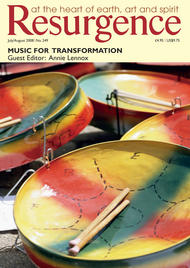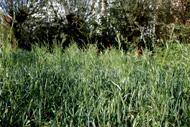IN THE SCHOOLBOOKS we read as children, farm life was idyllic. See the farmer milking his cows, taking care of his chickens and pigs. Later he’ll get on his little tractor and plough his field to plant vegetables, which he’ll give to his wife to make soup for the children. Everyone, down to the earthworms that fertilise the soil, is smiling.
In reality, the self-sufficient farms and farmers Thomas Jefferson hoped would form the backbone of a democratic polity scarcely exist any more. The best farmland in the Midwest is a vast monoculture of corn to make the sugar and fat in the fake food you get at the supermarket. Farm animals live their short, unhappy lives in squalid prisons. Vegetables are bred for pesticide tolerance and uniformity for shipping. Farmers have been driven off the land, or trapped in a complex scheme of indebtedness that holds them hostage to forces beyond their control. Nobody, it seems, is smiling.
In the Berkshire Hills of Western Massachusetts where I live, the landscape was once a mosaic of small farms. People grew or made most things they needed, and traded in small market towns for what they couldn’t produce themselves. My town, Great Barrington, Massachusetts, prides itself on being the site of the first open resistance to British rule in North America. In 1774, a mob of farmers chased the King’s judge from the courthouse. The last battle of Shay’s Rebellion – a post-revolutionary dispute that pitted hill farmers against Boston speculators backed by the state militia – was fought just down the road in Egremont.
There’s a lesson here: people who can supply all their needs from a small patch of ground are not as easily pushed around as those who depend on an employer for their livelihood. Small farmers can be troublesome, which could explain why the government does not go out of its way to help them.
Farming here began to decline after the Civil War, when reports of Iowa topsoil ten feet deep prompted many to abandon their marginal farms. It’s common, when walking in the woods, to come across the cellar holes of old farmhouses, their stacked stone walls still straight as a string. Dairying on the best farms in the river bottoms went out twenty years ago, done in by milk prices that have not risen in a generation.
But in the last few years, a funny thing has happened: small-scale farming has made a comeback, based on a new economic model: community-supported agriculture, which allows farmers to sell their crops before they plant them to the people who are going to eat the end produce. Getting paid up front takes a lot of the guesswork and the risk out of farming, and a generation of Americans raised on supermarket produce has discovered how good food can be.
We have a number of friends who raise chickens, so now I have eggs for breakfast every morning. We buy beef over in New York State from a fellow who labels the freezer packages with the name of the cow whence it came. All our bread comes from a bakery just up the road that’s run by an impassioned French Canadian. Another friend has built a distillery and is making some pretty good hooch.
I owe it all to my wife, the author of 1001 Bad Things That Can Happen If You Don’t Watch Out. About the time we had children, she concluded that government and industry were conspiring to poison us. They do it nice and slow, starting with vaccines and school lunches, and then with fast food and cigarettes, so that before you go, you’ve spent all your money on pharmaceuticals. Corporations, in other words, are farming us. So we’ve opted out, abandoning traditional medicine for witch doctors – naturopaths, chiropractors, acupuncturists. Our families regard this as eccentric at best, but we feel fine.
We have started an enormous kitchen garden where we grow bumper crops of lettuces, squashes and tomatoes. We plant heirloom seeds from High Mowing Seed Company in Wolcott, Vermont, which is – no lie – the next town over from Eden. When I met founder Tom Stearns about ten years ago he looked like a clueless hippie who was about to starve to death, but now it’s a giant business, shipping seeds all over the country.
You can grow tomatoes like you’d never see in a store: red and pink and yellow and purple, big and small, round or oblate or pear- or grape-shaped. The melons and the lettuces and the root vegetables are like a rainbow. We have quit eating California tomatoes in the winter – they feel and taste just like tennis balls. At high tomato time in late summer, we make a giant pot of marinara sauce and a load of salsa fresca and we lay it down in freezer bags, so we can taste the summer when the snow starts to fly.
It takes a little more time, effort and thought to live this way, but we eat really well and we support our friends and neighbours in their endeavours, just as they support us, instead of sending all our money away. Somewhere, Jefferson is smiling.
Veteran newspaper reporter Daniel Bellow is helping to start hotfrog.org, a green internet magazine and networking site.








